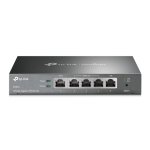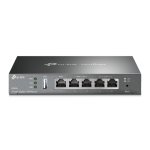ForkWNY
Senior Member
I've been thinking of ordering a TP-Link ER605 to handle dual WAN between two high-speed ISP's, Fios (1 Gb up/down) and Spectrum (1 Gb down/40mb up). Currently I'm using my GT-AC5300 to handle Dual WAN, but the firmware is buggy at best and doesn't even handle failover/fail-back properly, and load balancing is a complete wreck at best. I have 4 AiMesh nodes connected to the GT-AC5300 via wire in ethernet backhaul mode, so ditching the GT-AC5300 isn't an option. I just want something to handle WAN failover/load balancing reliably.
Is it possible to put the TP-Link ER605 in front of the entire network, connecting to the two WAN devices, and placing the GT-AC5300 behind it, connecting the ER605 LAN port into the GT-AC5300 WAN port? I'm presuming I'll lose functionality such as DDNS, etc. on the ASUS and end up with a double NAT situation? Or is it possible to completely disable NAT/DHCP on the TP-Link ER605? I'm not really interested in load balancing as much as I am just having reliable failover...the problem I foresee with load balancing relates to upload speed...upload is 20x faster over Fios vs Spectrum, so I'd rather not see any clients sent outbound over spectrum due to the limited upstream bandwidth. If Fios goes down, I simply want to failover to Spectrum. Load balancing would only make sense if both WAN's were the same speed, or one WAN was being saturated over another. What happens to port forwarding in this situation? I have port forwarding/DDNS set up on the GT-AC5300, and am hoping I can maintain that configuration somehow with another router out in front.
Any basic setup suggestions would be greatly appreciated, as I haven't really dabbled with placing one router in front of another one, at least not for a home network. Thanks.
Is it possible to put the TP-Link ER605 in front of the entire network, connecting to the two WAN devices, and placing the GT-AC5300 behind it, connecting the ER605 LAN port into the GT-AC5300 WAN port? I'm presuming I'll lose functionality such as DDNS, etc. on the ASUS and end up with a double NAT situation? Or is it possible to completely disable NAT/DHCP on the TP-Link ER605? I'm not really interested in load balancing as much as I am just having reliable failover...the problem I foresee with load balancing relates to upload speed...upload is 20x faster over Fios vs Spectrum, so I'd rather not see any clients sent outbound over spectrum due to the limited upstream bandwidth. If Fios goes down, I simply want to failover to Spectrum. Load balancing would only make sense if both WAN's were the same speed, or one WAN was being saturated over another. What happens to port forwarding in this situation? I have port forwarding/DDNS set up on the GT-AC5300, and am hoping I can maintain that configuration somehow with another router out in front.
Any basic setup suggestions would be greatly appreciated, as I haven't really dabbled with placing one router in front of another one, at least not for a home network. Thanks.
Last edited:



